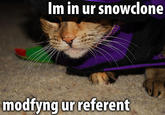Snowclone
Confirmed 979,781
Part of a series on Internet Slang. [View Related Entries]
Snowclone
Part of a series on Internet Slang. [View Related Entries]
[View Related Sub-entries]
About
Snowclones are a type of phrasal templates[2] in which certain words may be replaced with another to produce new variations with altered meanings, similar to the "fill-in-the-blank" game of Mad Libs. Although freeform parody of quotes from popular films, music and TV shows is a fairly common theme in Internet humor, snowclones usually adhere to a particular format or arrangement order which may be reduced down to a grammatical formula with one or more custom variables. They can be understood as the verbal or text-based form of photoshopped exploitables.
Origin
The term "snowclone" was coined by American linguists Geoffrey K. Pullum and Glen Whitman through a series of short columns published via Language Log.[14] The earliest known discussion about the term can be found in Pullum's blog post titled "Phrases for Lazy Writers in Kit Form"[6] published in October 2003. In the article, Pullum asserted there has been a growing need of a descriptor for overused phrasal templates or journalism cliches:
It now occurs to me that we also need a name for another linguistic figure, also noted by Mark but not yet named. Roughly speaking, the thing we need a name for is a multi-use, customizable, instantly recognizable, time-worn, quoted or misquoted phrase or sentence that can be used in an entirely open array of different jokey variants by lazy journalists and writers.
On January 16th, 2004, Pellum wrote about his colleague Glen Whitman's suggested neologism "snow clone,"[7] thus formally introducing the term to his readers for the first time. Soon thereafter, Pellum began tracking the history of widespread snow clones and documented his findings on his blog.
Spread
Pullum continued his documentation project for several years, accumulating more than 70 widespread examples of snowclone phrases, including "X as the Y of Z," "You can call it X all you want" and "Putting the X in Y" among many others. The Wikipedia entry[1] for "snowclone" was created by user Bradeos Graphon in October 2005. Weeks later, the article was temporarily removed from Wikipedia on grounds that the term was not sufficiently notable, but it was revived a few months later with an extensive list of snowclones and writers' cliches that are maintained to this day.
Coverage in Blogs
The term received its first mainstream exposure in December 2005, when tech journalist David Rowan introduced the concept of snowclones in his Trendsurfing[12] column series for the UK Times. In November 2006, weekly international science magazine New Scientist[9] published an article about Pellum and other linguists' effort to document the history of snowclones.
In June 2007, Mental Floss[11] blogger Chris Higgins posted a similar article on his blog. In February 2008, technology columnist Paul McFedries wrote an introductory article about the phenomenon for Spectrum Magazine[8] published by the Institute of Electrical and Electronics Engineers' (IEEE). In the article, McFedries listed several examples of snowclones originally compiled by Pellum, including "I'm not an X, but I play one on TV", "I, for one, welcome our new X overlords" and "I'm in ur X, Y-ing ur Z".
The Snowclones Database
In November 2007, linguistics student Erin O'Connor launched a website called The Snowclones Database[3] to compile a comprehensive list of widespread snowclones on the web. According to the site description, the database was inspired by the bloggers of Language Log and Eggcorn Database, a resource site devoted to documenting English words that are commonly misspelled or mistaken with other words.

The database also offers a pragmatic definition of a snowclone determined by the scale of variations in Google search results. It also considers snowclones as a subset of cliches, which refers to any phrase or quote that is overused and signifies unoriginality.
Notable Examples
Editor's Note: This is an incomplete list.
|
|
Search Interest
External References
[2] Wikipedia – Phrasal Template
[3] Snowclones – The Snowclone Database
[4] LiveJournal – A bit of Language Log-ish geekery
[6] Language Log – PHRASES FOR LAZY WRITERS IN KIT FORM
[7] Language Log – SNOWCLONES: LEXICOGRAPHICAL DATING TO THE SECOND
[8] Spectrum – Snowclone Is The New Cliche
[9] New Scientist – The word / Snowclone
[10] TVTropes – Everything's Worse with Snowclones
[11] Mental Floss – Snowclones
[12] David Rowan – Trendsurfing – Snowclone Journalism
[13] WiseGeek – What is a Snowclone?
[14] University of Pennsylvania – Language Log
Recent Videos
There are no videos currently available.
Recent Images 2 total
Share Pin
Related Entries 547 total
Sub-entries 228 total
Recent Images 2 total
Recent Videos 0 total
There are no recent videos.




Top Comment
Xanofar
May 24, 2012 at 12:59AM EDT